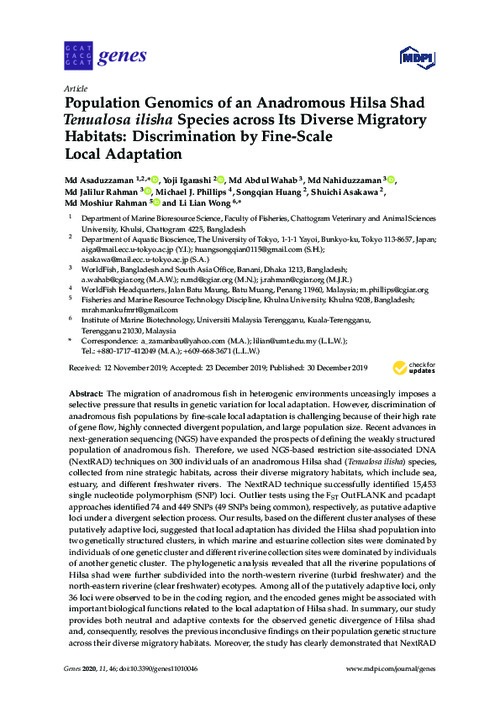Please use this identifier to cite or link to this item:
https://hdl.handle.net/20.500.12348/3878
Population genomics of an anadromous Hilsa Shad Tenualosa ilisha species across its diverse migratory habitats: Discrimination by fine-scale local adaptation
| dc.creator | Asaduzzaman, M. | en_US |
| dc.creator | Abdul, W.M. | en_US |
| dc.creator | Igarashi, Y. | en_US |
| dc.creator | Md, N. | en_US |
| dc.creator | Rahman, M.J. | en_US |
| dc.creator | Phillips, M. | en_US |
| dc.creator | Huang, S.Q. | en_US |
| dc.creator | Asakawa, S. | en_US |
| dc.creator | Rahman, M.M. | en_US |
| dc.creator | Wong, L.L. | en_US |
| dc.date.accessioned | 2020-02-03T10:08:49Z | |
| dc.date.available | 2020-02-03T10:08:49Z | |
| dc.date.issued | 2020 | |
| dc.identifier.citation | Genes, 11(1): 46. | en_US |
| dc.identifier.issn | 2073-4425 | en_US |
| dc.identifier.uri | https://hdl.handle.net/20.500.12348/3878 | |
| dc.description.abstract | The migration of anadromous fish in heterogenic environments unceasingly imposes a selective pressure that results in genetic variation for local adaptation. However, discrimination of anadromous fish populations by fine-scale local adaptation is challenging because of their high rate of gene flow, highly connected divergent population, and large population size. Recent advances in next-generation sequencing (NGS) have expanded the prospects of defining the weakly structured population of anadromous fish. Therefore, we used NGS-based restriction site-associated DNA (NextRAD) techniques on 300 individuals of an anadromous Hilsa shad (Tenualosa ilisha) species, collected from nine strategic habitats, across their diverse migratory habitats, which include sea, estuary, and di erent freshwater rivers. The NextRAD technique successfully identified 15,453 single nucleotide polymorphism (SNP) loci. Outlier tests using the FST OutFLANK and pcadapt approaches identified 74 and 449 SNPs (49 SNPs being common), respectively, as putative adaptive loci under a divergent selection process. Our results, based on the di erent cluster analyses of these putatively adaptive loci, suggested that local adaptation has divided the Hilsa shad population into two genetically structured clusters, in which marine and estuarine collection sites were dominated by individuals of one genetic cluster and di erent riverine collection sites were dominated by individuals of another genetic cluster. The phylogenetic analysis revealed that all the riverine populations of Hilsa shad were further subdivided into the north-western riverine (turbid freshwater) and the north-eastern riverine (clear freshwater) ecotypes. Among all of the putatively adaptive loci, only 36 loci were observed to be in the coding region, and the encoded genes might be associated with important biological functions related to the local adaptation of Hilsa shad. In summary, our study provides both neutral and adaptive contexts for the observed genetic divergence of Hilsa shad and, consequently, resolves the previous inconclusive findings on their population genetic structure across their diverse migratory habitats. Moreover, the study has clearly demonstrated that NextRAD sequencing is an innovative approach to explore how dispersal and local adaptation can shape genetic divergence of non-model anadromous fish that intersect diverse migratory habitats during their life-history stages. | en_US |
| dc.format | en_US | |
| dc.language | en | en_US |
| dc.publisher | MDPI | |
| dc.relation | Shiv Kumar Agrawal, Sripada M. Udupa, Michael Baum. (26/2/2014). Genomics enabled improvement of lentil. Amman, Jordan: International Center for Agricultural Research in the Dry Areas (ICARDA). | en_US |
| dc.relation | Wahab Abdul. (13/3/2017). Hilsa conservation and building livelihood resilience. Bayan Lepas, Malaysia: WorldFish (WF) (Executive Producer). | en_US |
| dc.relation.uri | https://hdl.handle.net/20.500.11766/5663 | en_US |
| dc.relation.uri | https://hdl.handle.net/20.500.11766/10429 | en_US |
| dc.rights | CC-BY-4.0 | en_US |
| dc.subject | conservation | en_US |
| dc.subject | conservation genetics | en_US |
| dc.subject | anadromous fish | en_US |
| dc.subject | nextrad sequencing | en_US |
| dc.subject | migratory fish | en_US |
| dc.title | Population genomics of an anadromous Hilsa Shad Tenualosa ilisha species across its diverse migratory habitats: Discrimination by fine-scale local adaptation | en_US |
| dc.type | Journal Article | en_US |
| dcterms.bibliographicCitation | Asaduzzaman, M. et al. (2020). Population genomics of an anadromous Hilsa Shad Tenualosa ilisha species across its diverse migratory habitats: Discrimination by fine-scale local adaptation. Genes, 11(1): 46. | |
| cg.contributor.crp | Fish | en_US |
| cg.contributor.funder | United States Agency for International Development | en_US |
| cg.coverage.country | Bangladesh | en_US |
| cg.coverage.region | Southern Asia | en_US |
| cg.identifier.worldfish | 4513 | |
| cg.subject.agrovoc | selection | en_US |
| cg.subject.agrovoc | population structure | en_US |
| cg.subject.agrovoc | genetics | en_US |
| cg.subject.agrovoc | hilsa | en_US |
| cg.contributor.affiliation | Chittagong Veterinary and Animal Sciences University | en_US |
| cg.contributor.affiliation | WorldFish | en_US |
| cg.contributor.affiliation | The university of Tokyo | en_US |
| cg.contributor.affiliation | Khulna University | en_US |
| cg.contributor.affiliation | Universiti Malaysia Terengganu | en_US |
| cg.identifier.status | Open access | en_US |
| cg.identifier.ISIindexed | ISI indexed | en_US |
| cg.contribution.worldfishauthor | Abdul, W.M. | en_US |
| cg.contribution.worldfishauthor | Md, N. | en_US |
| cg.contribution.worldfishauthor | Rahman, M.J. | en_US |
| cg.contribution.worldfishauthor | Phillips, M. | en_US |
| cg.description.theme | Resilient small-scale fisheries | en_US |
| dc.identifier.doi | https://dx.doi.org/10.3390/genes11010046 | en_US |
| cg.creator.id | Nahiduzzaman Md: 0000-0002-5152-992X | en_US |
| cg.creator.id | Michael John Phillips: 0000-0002-0282-0286 | en_US |
